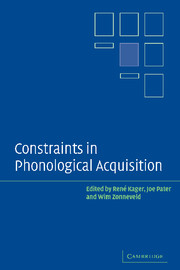Book contents
- Frontmatter
- Contents
- List of contributors
- Abbreviations
- Preface
- 1 Introduction: constraints in phonological acquisition
- 2 Saving the baby: making sure that old data survive new theories
- 3 Markedness and faithfulness constraints in child phonology
- 4 Input elaboration, head faithfulness, and evidence for representation in the acquisition of left-edge clusters in West Germanic
- 5 Phonological acquisition in Optimality Theory: the early stages
- 6 Syllable types in cross-linguistic and developmental grammars
- 7 Bridging the gap between receptive and productive development with minimally violable constraints
- 8 Learning phonotactic distributions
- 9 Emergence of Universal Grammar in foreign word adaptations
- 10 The initial and final states: theoretical implications and experimental explorations of Richness of the Base
- 11 Child word stress competence: an experimental approach
- Index of subjects
- Index of names
3 - Markedness and faithfulness constraints in child phonology
Published online by Cambridge University Press: 22 September 2009
- Frontmatter
- Contents
- List of contributors
- Abbreviations
- Preface
- 1 Introduction: constraints in phonological acquisition
- 2 Saving the baby: making sure that old data survive new theories
- 3 Markedness and faithfulness constraints in child phonology
- 4 Input elaboration, head faithfulness, and evidence for representation in the acquisition of left-edge clusters in West Germanic
- 5 Phonological acquisition in Optimality Theory: the early stages
- 6 Syllable types in cross-linguistic and developmental grammars
- 7 Bridging the gap between receptive and productive development with minimally violable constraints
- 8 Learning phonotactic distributions
- 9 Emergence of Universal Grammar in foreign word adaptations
- 10 The initial and final states: theoretical implications and experimental explorations of Richness of the Base
- 11 Child word stress competence: an experimental approach
- Index of subjects
- Index of names
Summary
Introduction
This chapter argues that constraint-based Optimality Theory (Prince and Smolensky 1993) provides a framework which allows for the development of a unified model of child and adult phonology and the relation between the two. In Optimality Theory (OT) an adult phonology consists of a set of ranked constraints. The ranking, but not the constraints, differs from language to language. The constraints are universal. If phonological constraints are universal, they should be innate. I claim that these innate constraints are operative in child phonology. The constraints used in adult language should therefore be adequate to account for child phonology data as well, without attributing to the child, as in previous theories, more representational levels or more rules than adults have. This chapter shows that this is indeed the case.
The initial state of the phonology, I propose, is one in which constraints against phonological markedness outrank the faithfulness constraints, which demand that the surface form (output) is identical to the underlying form (input, in OT terminology). The result is that in the initial stages of acquisition the outputs are unmarked. The process of acquisition is one of promoting the faithfulness constraints to approximate more and more closely the adult grammar, and produce more and more marked forms. The path of acquisition will vary from child to child, as different children promote the various faithfulness constraints in different orders.
In adult languages certain faithfulness constraints outrank certain markedness constraints.
- Type
- Chapter
- Information
- Constraints in Phonological Acquisition , pp. 73 - 108Publisher: Cambridge University PressPrint publication year: 2004
- 66
- Cited by



